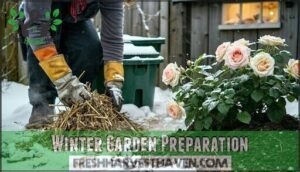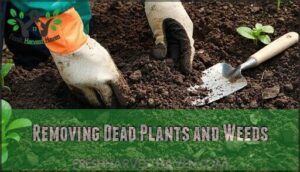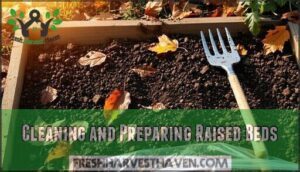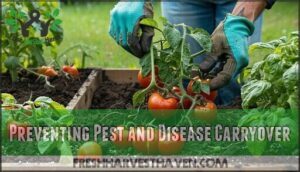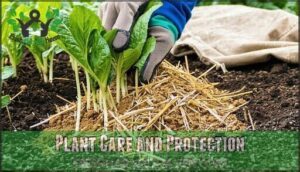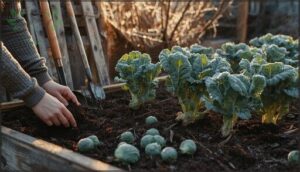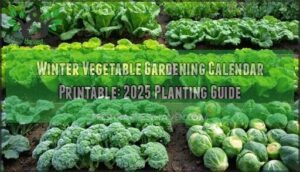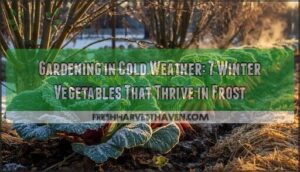This site is supported by our readers. We may earn a commission, at no cost to you, if you purchase through links.
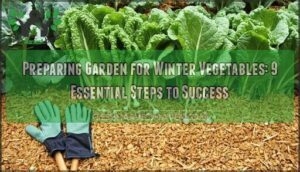 Start preparing garden for winter vegetables 10-14 weeks before your first frost date.
Start preparing garden for winter vegetables 10-14 weeks before your first frost date.
Clear out spent summer crops and weeds, then test your soil pH—most winter vegetables thrive in slightly alkaline conditions around 6.0-7.0.
Add 2-4 inches of compost to boost organic matter and improve drainage.
Choose cold-hardy varieties like kale, Brussels sprouts, and winter radishes that can handle temperature drops.
Plan your layout considering each crop’s mature size and light requirements.
Clean and disinfect tools to prevent disease carryover.
The secret timing techniques and frost protection methods that separate successful winter gardeners from the disappointed ones require understanding your local microclimate patterns.
Table Of Contents
- Key Takeaways
- Winter Garden Preparation
- Garden Bed Maintenance
- Plant Care and Protection
- Winter Gardening Tips
- Frequently Asked Questions (FAQs)
- How do I get my vegetable garden ready for winter?
- How to prepare flower beds for winter in Canada?
- What do you do with your vegetables in the winter?
- What is the best winter cover crop for a vegetable garden?
- How do I prepare my vegetable garden for winter?
- Should I fertilize my vegetable garden before winter?
- When should I start my winter vegetable garden?
- How to prepare a tomato garden for winter?
- How to attract pollinators in colder months?
- What irrigation techniques are best in winter?
- Conclusion
Key Takeaways
- Start early with soil prep – Begin 10-14 weeks before the first frost by clearing spent crops, testing soil pH (aim for 6.0-7.0), and adding 2-4 inches of compost to improve drainage and nutrition.
- Choose cold-hardy varieties strategically – Plant vegetables like kale, Brussels sprouts, and winter radishes that actually thrive in cold temperatures and develop sweeter flavors after frost exposure.
- Plan your layout for winter conditions – Map sunlight patterns during shorter days, position tall plants north of shorter ones, and use walls or structures for wind protection in your microclimate.
- Protect plants with proven methods – Use frost cloths for temperatures of 20-28°F, apply mulch around plant bases for insulation, and water in the morning to prevent ice crystal formation on leaves.
Winter Garden Preparation
You’ll need to shift your garden’s focus from summer crops to cold-hardy vegetables that thrive in cooler temperatures.
Start by testing your soil and planning which winter varieties will work best in your specific growing zone and garden layout, considering complete concepts to ensure a successful transition.
Seed Collection and Storage
Collecting seeds from your winter vegetables sets you up for next season’s success. Proper seed viability depends on timing and technique.
Here’s your systematic approach to seed storage:
- Harvest at peak maturity – Seeds need full development on the plant before collection for maximum germination rates
- Apply proper drying methods – Spread seeds on screens for 7-14 days until moisture drops below 8% to prevent mold
- Use appropriate storage containers – Airtight glass jars with silica gel packets maintain ideal conditions for winter vegetable seeds
- Implement clear labeling practices – Mark each container with variety, collection date, and source for effective seed organization
Store containers in cool, dry locations below 50°F. Consider using specialized drying equipment for superior results.
Test germination rates annually by placing ten seeds on moist paper – anything below 70% viability means it’s time for fresh stock. This winter preparation guarantees reliable vegetable gardening success.
Garden Layout Planning
Now that you’ve collected and stored your seeds, it’s time to map out your winter garden like a chess master planning their next move. Garden layout planning transforms scattered ideas into a productive vegetable garden beds system.
Start with sunlight mapping – track how winter sun hits your garden beds. Those shorter days mean every ray counts. Space optimization becomes critical when growing space feels tight. Position tall plants north of shorter ones to prevent shading.
Crop rotation keeps soil healthy by moving plant families to different spots each season. Your garden structure should account for microclimate design – sheltered spots stay warmer while exposed areas catch more wind.
| Layout Factor | Winter Consideration | Action Step |
|---|---|---|
| Sunlight Mapping | Reduced daylight hours | Track shadows at noon |
| Space Optimization | Limited growing season | Group compatible plants |
| Crop Rotation | Soil nutrient management | Move plant families annually |
| Microclimate Design | Temperature variations | Use walls for wind protection |
Smart garden planning means raised beds positioned for easy access during snowy months while maximizing winter aesthetics.
Companion Planting Considerations
Within your winter vegetable gardening plan, beneficial plant pairings create natural harmony.
Garlic and carrots form excellent pest deterrents against carrot flies, while cabbage paired with dill attracts beneficial insects for pollinator attraction.
Achieve nutrient synergy by combining peas with lettuce—nitrogen fixation meets shade tolerance.
Space optimization works when spinach grows alongside radishes, maximizing your cold season crops through smart vegetable crop rotation that enhances soil health and pest reduction.
Interpreting Soil Test Results
The soil test reveals your garden’s nutrient levels and pH balance, acting like a health report for your plants.
Look for nutrient deficiencies in nitrogen, phosphorus, and potassium—these directly impact winter vegetable growth. Check soil pH levels; most winter crops thrive between 6.0-7.0.
Note lead levels and organic matter percentages too. To accurately assess your soil, consider using a reliable testing product.
Your results guide precise pH adjustment and soil amendments, ensuring you’re not guessing but strategically preparing beds for ideal nutrient balance this winter season.
Adding Compost and Organic Matter
Once you’ve interpreted your soil test results, it’s time to feed your garden.
Compost benefits your soil by improving structure and water retention. Spread 2-3 inches of finished compost across beds this fall.
Manure types like aged cow or horse manure work well, but avoid fresh manure which burns plants. Worm castings provide gentle, slow-release nutrients that boost soil biodiversity.
Layer organic matter using cardboard, leaves, and compost – this garden soil preparation method creates rich growing medium. Organic fertilizers break down slowly over winter, feeding beneficial microorganisms.
Your garden composting tips pay off when spring arrives with healthier soil health.
Adjusting Soil PH Levels
Getting your soil pH right makes all the difference for winter vegetable success.
Your soil test reveals whether you’re dealing with acidic or alkaline conditions, guiding your next moves.
Apply these soil amendments based on your results:
Your soil test results become your blueprint—apply lime for acidic soil, sulfur for alkaline conditions, and compost to naturally balance pH levels.
- Lime for acidic soil (pH below 6.0)
- Sulfur for alkaline soil (pH above 7.0)
- Compost to buffer pH naturally
- Regional variations require different amendment types
Fall’s your window for pH adjustment since winter weather helps these amendments integrate slowly into your soil structure, setting up ideal pH range conditions for spring planting.
Proper soil structure guarantees adequate soil aeration.
Garden Bed Maintenance
Proper garden bed maintenance creates the foundation for successful winter vegetable growing by eliminating disease sources and preparing clean growing spaces.
You’ll need to remove all dead plant material, clean your beds thoroughly, and take steps to prevent pests and diseases from surviving the winter months, which is crucial for successful winter vegetable growing and requires thorough cleaning.
Removing Dead Plants and Weeds
Complete garden cleanup begins with systematic removal of all dead vegetation and weeds from your beds.
Disease Prevention starts here—diseased plants must go in household trash, never compost. Weed Identification helps you target problem species before they spread seeds.
Pull weeds by hand or use a hoe for stubborn roots.
Proper Disposal prevents Pest Control issues next season.
This winter garden prep step protects Soil Health by eliminating overwintering diseases and pests that damage future crops.
Cleaning and Preparing Raised Beds
Everyone knows that a clean slate makes for better planting outcomes.
Remove all plant debris and weeds from your raised beds before winter sets in. Check your bed frame repair needs – loose boards or damaged corners can worsen during freeze-thaw cycles.
Improve raised bed drainage by loosening compacted soil with a fork. Amending clay soil with compost now prevents spring headaches.
Consider soil solarization using clear plastic if disease was an issue. Add organic matter to boost soil health during your garden cleanup.
This garden bed preparation sets up your vegetable garden for winter cover crops success. Proper garden preparation pays dividends come spring planting season.
Preventing Pest and Disease Carryover
Your clean raised beds won’t stay healthy without addressing overwintering pests lurking in plant debris. Remove garden debris immediately—diseased material harbors pathogens through winter.
Crop rotation benefits include breaking pest cycles naturally. Soil solarization heats soil under plastic, killing harmful organisms. Beneficial nematodes target soil-dwelling larvae for pest control.
One key is to also manage environmental factors affecting disease. Winter sanitation prevents disease prevention failures.
This systematic approach protects soil health before spring planting begins.
Disinfecting Gardening Tools
Clean garden tools prevent disease spread between plants and seasons. Proper disinfection protects your winter vegetables from harmful pathogens.
Clean tools today, healthy harvests tomorrow.
- Remove debris – Scrub off soil, sap, and plant material with warm soapy water
- Apply disinfectant – Use bleach solutions (1:10 ratio) or 70% rubbing alcohol for thorough cleaning
- Address rust removal – Sand rough spots and apply rust converter if needed
- Sharpen blades – Tool sharpening guarantees clean cuts that heal faster, reducing disease entry points
- Protect with oil application – Coat metal surfaces with light oil before storage methods like hanging or toolshed placement
This routine eliminates garden pests and garden diseases while extending tool life for disease prevention. You can find a suitable tool disinfectant online.
Plant Care and Protection
Beyond winter’s harsh grip, your plants need strategic protection to survive freezing temperatures and thrive come spring.
Mulch Application around plant bases creates insulation barriers.
Frost Cloths shield tender crops when temperatures drop below 32°F.
Wind Protection using barriers reduces cold stress substantially.
| Protection Method | Temperature Range |
|---|---|
| Light mulch layer | 28-32°F |
| Frost cloth coverage | 20-28°F |
| Combined barriers | Below 20°F |
Watering Strategies involve morning hydration to prevent ice crystal formation.
Pruning Techniques remove damaged foliage before cold snaps.
Monitor soil moisture levels consistently throughout winter months for ideal plant protection and successful winter garden care.
Winter Gardening Tips
Winter gardening extends your growing season well beyond summer’s end, turning cold months into productive harvest time.
You’ll discover that cool-season crops like kale, Brussels sprouts, and winter radishes actually thrive in frost, developing sweeter flavors that summer heat can’t produce.
Growing Garlic and Winter Crops
Garlic planting starts your winter garden success story.
Plant hardneck Garlic Varieties in fall, 2-4 inches deep with proper spacing for maximum Cold Hardiness.
Winter Crop Selection requires timing—plant before ground freezes but after soil cools.
These cool season vegetables need winter’s chill for proper bulb development.
Here are three key Winter Crop Selection strategies:
- Choose hardneck varieties for superior winter vegetable planting success in northern climates
- Time Planting Timeframes correctly—4-6 weeks before hard frost guarantees root establishment
- Mulch heavily with straw for winter garden preparation and enhanced Pest Resistance
Using Cold Frames and Frost Protection
Cold frame design maximizes sunlight exposure while providing ventilation control for winter vegetable planting.
Position frames facing south for maximum solar gain. Various frost blanket types offer different protection levels – choose based on your climate zone.
Heating cold frames with thermal mass like water jugs maintains consistent temperatures. Monitor watering under protection carefully, as covered plants need less moisture.
These garden frost protection methods successfully extend your growing season.
Pruning and Caring for Fruit Bushes
Winter is the perfect time to tackle Berry Bush Pruning for healthier spring growth. Clean tools prevent disease spread between cuts. Focus on removing damaged canes and supporting structures.
Here’s your winter fruit bush care checklist:
- Prune raspberry canes – Cut summer-bearing varieties to 6 vigorous brown canes per foot
- Support blueberry branches – Install stakes or cages to prevent snow damage
- Apply thin mulch layer – Use straw around berry patches for root protection
- Water deeply before freeze – Meet Winter Watering Needs with thorough soil saturation
- Remove diseased material – Burn or trash infected branches for Pest Protection
Proper Mulching Techniques and winter protection guarantee your berry patches bounce back stronger than ever. Applying mulch helps with insulating root systems.
Preparing for Spring Planting
After winter pruning, focus on spring soil prep for ideal planting success.
Test soil pH and add compost now for soil health protection.
Start seed starting indoors six weeks before your frost date planning window.
Inspect garden tool maintenance needs and sharpen blades.
| Task | Timing |
|---|---|
| Soil testing | 6-8 weeks before frost date |
| Seed starting indoors | 6 weeks before last frost |
| Garden tool maintenance | Late winter |
| Cover crop termination | 2-4 weeks before planting |
| Bed preparation | 4 weeks before planting |
Plant winter garden cover crops like rye for early growth advantage.
These early bloomers create nitrogen-rich soil and prevent erosion.
Your winter garden soil improvement efforts pay off with healthier spring plants and better yields.
Frequently Asked Questions (FAQs)
How do I get my vegetable garden ready for winter?
Remove spent crops, add 2-3 inches of compost, and cover beds with mulch or plastic. Plant hardy greens like kale, sow garlic cloves, and protect tender plants with row covers.
How to prepare flower beds for winter in Canada?
Clean up fallen leaves and debris, then cut perennials back to 3-4 inches.
Apply mulch around plants and test soil pH.
Add compost to enrich beds over winter for spring growth.
What do you do with your vegetables in the winter?
Root vegetables can survive winter temperatures down to 20°F when properly stored underground.
You’ll harvest tender crops before frost, protect hardy greens with row covers.
Store root vegetables in cool cellars or leave them buried until needed.
What is the best winter cover crop for a vegetable garden?
Winter rye stands out as your best bet for vegetable gardens. It’s hardy, prevents erosion, adds nitrogen to soil, and you’ll easily turn it under come spring planting time.
How do I prepare my vegetable garden for winter?
Harvest tender crops before frost, then add compost to beds and cover with mulch or straw.
Plant winter cover crops like rye, test soil pH, and protect hardy vegetables with row covers for continued growth, focusing on complete concepts for efficient gardening.
Should I fertilize my vegetable garden before winter?
Ironically, feeding plants before their winter dormancy seems backwards, but you shouldn’t fertilize vegetables before winter.
Stop fertilizing six weeks before first frost.
Instead, add compost or organic amendments that’ll break down slowly over winter, enriching soil for spring planting without promoting vulnerable new growth, which is a key concept to prevent vulnerable new growth.
When should I start my winter vegetable garden?
Plant your winter vegetables 10-12 weeks before your first hard frost. Hardy greens like kale and Brussels sprouts need time to establish before cold weather hits your garden.
How to prepare a tomato garden for winter?
Tomato plants don’t survive freezing temperatures—they’re gone at 32°F. Remove all plants before frost, clearing debris to prevent pests overwintering in your garden beds this season.
How to attract pollinators in colder months?
Bees still forage on warm winter days above 55°F.
Plant early bloomers like snowdrops, crocuses, winter aconite, and camellias.
These plants greatly contribute to local pollinator success during late fall through early spring.
These flowers provide essential winter forage for bees active in colder months, which is crucial for their winter survival.
What irrigation techniques are best in winter?
Winter irrigation requires minimal water since most vegetables are dormant or slow-growing.
Water deeply but infrequently when soil isn’t frozen.
Check soil moisture regularly—you’ll want consistent dampness, not sogginess, which prevents root rot.
Conclusion
Winter’s approach transforms your garden into a canvas of opportunity, where proper preparation paints the foundation for months of fresh harvests.
Successful preparing garden for winter vegetables requires strategic timing and systematic execution. You’ve learned the essential steps: soil testing, composting, variety selection, and tool sanitation.
Your microclimate understanding separates success from disappointment. With proper planning, you’ll harvest nutritious vegetables throughout winter’s coldest months.
Start early, stay consistent, and trust the process to ensure a successful winter garden.

